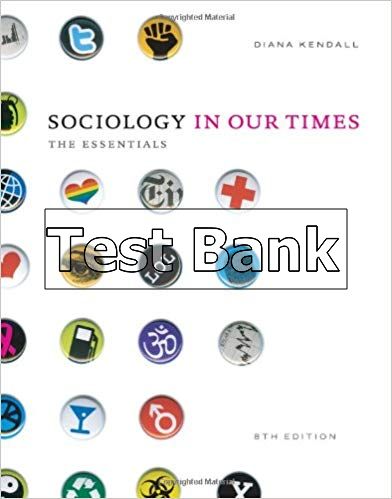$26.50$50.00 (-47%)
In stock
Sociology in Our Times The Essentials 8th Edition Kendall Test Bank.
You may also like
Sociology in Our Times The Essentials 8th Edition Kendall Test Bank

Product details:
- ISBN-10 : 1111305501
- ISBN-13 : 978-1111305505
- Author: Diana Kendall
Kendall’s SOCIOLOGY IN OUR TIMES: THE ESSENTIALS, Eighth Edition, uses real-life stories, told by the people who have lived them, as well as familiar themes such as the American Dream, body image, the environment, and fake news media to introduce you to the study of sociology and engage your sociological imagination, a vital resource you may not know you have. Kendall shows you how sociology is at work in our society and can be applied to everyday life and to the pressing social issues we face. Every chapter even includes a guide to how you can make a positive difference in both your immediate and extended communities.
Table contents:
The Sociological Perspective and Research Process 2
Putting Social Life into Perspective 4
Why Study Sociology? 4
The Sociological Imagination 5
The Importance of a Global Sociological Imagination 6
The Development of Sociological Thinking 8
Early Thinkers: A Concern with Social Order and Stability 9
Differing Views on the Status Quo: Stability Versus Change 12
The Beginnings of Sociology in the United States 14
Contemporary Theoretical Perspectives 15
Functionalist Perspectives 15
Conflict Perspectives 17
Symbolic Interactionist Perspectives 18
Postmodern Perspectives 20
The Sociological Research Process 21
The “Conventional” Research Model 22
A Qualitative Research Model 26
Research Methods 28
Survey Research 28
Secondary Analysis of Existing Data 31
Field Research 32
Experiments 33
Ethical Issues in Sociological Research 34
Culture 38
Culture and Society in a Changing World 40
Material Culture and Nonmaterial Culture 41
Cultural Universals 43
Components of Culture 46
Symbols 46
Language 47
Values 50
Norms 51
Technology, Cultural Change, and Diversity 53
Cultural Change 53
Cultural Diversity 54
Culture Shock 58
Ethnocentrism and Cultural Relativism 59
A Global Popular Culture? 60
High Culture and Popular Culture 60
Forms of Popular Culture 60
Sociological Analysis of Culture 62
Functionalist Perspectives 62
Conflict Perspectives 62
Symbolic Interactionist Perspectives 63
Postmodernist Perspectives 64
Culture in the Future 66
Socialization 70
Why Is Socialization Important Around the Globe? 72
Human Development: Biology and Society 72
Problems Associated with Social Isolation and Maltreatment 74
Social Psychological Theories of Human Development 77
Freud and the Psychoanalytic Perspective 77
Piaget and Cognitive Development 77
Kohlberg and the Stages of Moral Development 79
Gilligan’s View on Gender and Moral Development 80
Sociological Theories of Human Development 81
Cooley and the Looking-Glass Self 81
Mead and Role-Taking 81
Recent Symbolic Interactionist Perspectives 84
Agents of Socialization 84
The Family 85
The School 86
Peer Groups 87
Mass Media 87
Gender and Racial/Ethnic Socialization 90
Socialization Through the Life Course 91
Childhood 92
Adolescence 92
Adulthood 92
Late Adulthood and Ageism 93
Resocialization 94
Voluntary Resocialization 94
Involuntary Resocialization 95
Socialization in the Future 95
Social Groups and Social Control
Social Structure and Interaction in Everyday Life 100
Social Structure: The Macrolevel Perspective 102
Components of Social Structure 104
Status 104
Roles 108
Groups 111
Social Institutions 112
Societies: Changes in Social Structure 114
Durkheim: Mechanical and Organic Solidarity 114
Tonnies: Gemeinschaft and Gesellschaft 115
Industrial and Postindustrial Societies 116
Social Interaction: The Microlevel Perspective 117
Social Interaction and Meaning 117
The Social Construction of Reality 120
Ethnomethodology 121
Dramaturgical Analysis 122
The Sociology of Emotions 124
Nonverbal Communication 124
Changing Social Structure and Interaction in the Future 129
Groups and Organizations 132
Social Groups 134
Groups, Aggregates, and Categories 134
Types of Groups 134
Group Characteristics and Dynamics 138
Group Size 139
Group Leadership 140
Group Conformity 141
Groupthink 143
Formal Organizations in Global Perspective 144
Types of Formal Organizations 144
Bureaucracies 146
Problems of Bureaucracies 150
Bureaucracy and Oligarchy 152
Alternative Forms of Organization 152
Organizational Structure in Japan 153
Organizations in the Future 155
Deviance and Crime 158
What Is Deviance? 160
Who Defines Deviance? 161
What Is Social Control? 162
Functionalist Perspectives on Deviance 163
What Causes Deviance, and Why Is It Functional for Society? 163
Strain Theory: Goals and Means to Achieve Them 164
Opportunity Theory: Access to Illegitimate Opportunities 165
Conflict Perspectives on Deviance 166
Deviance and Power Relations 167
Deviance and Capitalism 167
Feminist Approaches 167
Approaches Focusing on Race, Class, and Gender 168
Symbolic Interactionist Perspectives on Deviance 168
Differential Association Theory and Differential Reinforcement Theory 169
Control Theory: Social Bonding 169
Labeling Theory 170
Postmodernist Perspectives on Deviance 171
Crime Classifications and Statistics 172
How the Law Classifies Crime 172
Other Crime Categories 172
Crime Statistics 177
Terrorism and Crime 178
Street Crimes and Criminals 178
Crime Victims 181
The Criminal Justice System 181
The Police 182
The Courts 183
Punishment and Corrections 184
Deviance and Crime in the United States in the Future 186
The Global Criminal Economy 187
3 Social Inequality
Class and Stratification in the United States 192
What Is Social Stratification? 194
Systems of Stratification 194
Slavery 195
The Caste System 198
The Class System 198
Classical Perspectives on Social Class 198
Karl Marx: Relationship to the Means of Production 199
Max Weber: Wealth, Prestige, and Power 200
Contemporary Sociological Models of the U.S. Class Structure 202
The Weberian Model of the U.S. Class Structure 202
The Marxian Model of the U.S. Class Structure 205
Inequality in the United States 208
Distribution of Income and Wealth 208
Consequences of Inequality 211
Poverty in the United States 216
Who Are the Poor? 217
Economic and Structural Sources of Poverty 219
Solving the Poverty Problem 219
Sociological Explanations of Social Inequality in the United States 220
Functionalist Perspectives 220
Conflict Perspectives 220
Symbolic Interactionist Perspectives 221
U.S. Stratification in the Future 223
Global Stratification 226
Wealth and Poverty in Global Perspective 228
Problems in Studying Global Inequality 231
The “Three Worlds” Approach 231
The Levels of Development Approach 231
Classification of Economies by Income 232
Low-Income Economies 232
Middle-Income Economies 233
High-Income Economies 235
Measuring Global Wealth and Poverty 235
Absolute, Relative, and Subjective Poverty 235
The Gini Coefficient and Global Quality-of-Life Issues 236
Global Poverty and Human Development Issues 236
Life Expectancy 237
Health 238
Education and Literacy 238
Persistent Gaps in Human Development 239
Theories of Global Inequality 239
Development and Modernization Theory 239
Dependency Theory 244
World Systems Theory 244
The New International Division of Labor Theory 246
Global Inequality in the Future 247
Race and Ethnicity 252
Race and Ethnicity 254
The Social Significance of Race and Ethnicity 256
Racial Classifications and the Meaning of Race 257
Dominant and Subordinate Groups 258
Prejudice 258
Stereotypes 258
Racism 259
Theories of Prejudice 260
Discrimination 260
Sociological Perspectives on Race and Ethnic Relations 262
Symbolic Interactionist Perspectives 262
Functionalist Perspectives 263
Conflict Perspectives 266
An Alternative Perspective: Critical Race Theory 268
Racial and Ethnic Groups in the United States 268
Native Americans 268
White Anglo-Saxon Protestants (British Americans) 272
African Americans 273
White Ethnic Americans 275
Asian Americans 276
Latinos/as (Hispanic Americans) 278
Middle Eastern Americans 280
Global Racial and Ethnic Inequality in the Future 281
Worldwide Racial and Ethnic Struggles 281
Growing Racial and Ethnic Diversity in the United States 281
Sex and Gender 286
Sex: The Biological Dimension 288
Hermaphrodites/Transsexuals 289
Sexual Orientation 290
Gender: The Cultural Dimension 292
The Social Significance of Gender 293
Sexism 294
Gender Stratification in Historical and Contemporary Perspective 294
Hunting and Gathering Societies 294
Horticultural and Pastoral Societies 295
Agrarian Societies 295
Industrial Societies 296
Postindustrial Societies 297
Gender and Socialization 298
Parents and Gender Socialization 298
Peers and Gender Socialization 299
Teachers, Schools, and Gender Socialization 300
Sports and Gender Socialization 301
Mass Media and Gender Socialization 302
Adult Gender Socialization 302
Contemporary Gender Inequality 303
Gendered Division of Paid Work 303
Pay Equity (Comparable Worth) 305
Paid Work and Family Work 308
Perspectives on Gender Stratification 309
Functionalist and Neoclassical Economic Perspectives 309
Conflict Perspectives 310
Feminist Perspectives 311
Gender Issues in the Future 313
Social Institutions
Families and Intimate Relationships 316
Families in Global Perspective 318
Family Structure and Characteristics 319
Marriage Patterns 321
Patterns of Descent and Inheritance 322
Power and Authority in Families 323
Residential Patterns 324
Theoretical Perspectives on Families 325
Functionalist Perspectives 326
Conflict and Feminist Perspectives 326
Symbolic Interactionist Perspectives 327
Postmodernist Perspectives 327
Developing Intimate Relationships and Establishing Families 328
Love and Intimacy 328
Cohabitation and Domestic Partnerships 329
Marriage 330
Housework and Child-Care Responsibilities 330
Child-Related Family Issues and Parenting 332
Deciding to Have Children 332
Adoption 333
Teenage Pregnancies 334
Single-Parent Households 334
Two-Parent Households 335
Remaining Single 336
Transitions and Problems in Families 336
Family Transitions Based on Age and the Life Course 336
Family Violence 338
Children in Foster Care 339
Elder Abuse 339
Divorce 340
Remarriage 342
Family Issues in the Future 343
Education and Religion 346
An Overview of Education and Religion 348
Sociological Perspectives on Education 348
Functionalist Perspectives on Education 349
Conflict Perspectives on Education 353
Symbolic Interactionist Perspectives on Education 357
Problems Within Elementary and Secondary Schools 359
Unequal Funding of Public Schools 359
School Violence 359
Dropping Out 360
Racial Segregation and Resegregation 360
Opportunities and Challenges in Colleges and Universities 361
Opportunities and Challenges in Community Colleges 361 Opportunities and Challenges in Four-Year Colleges and Universities 363
The Soaring Cost of a College Education 363
Racial and Ethnic Differences in Enrollment 364
Religion in Historical Perspective 365
Religion and the Meaning of Life 365
Religion and Scientific Explanations 366
Sociological Perspectives on Religion 368
Functionalist Perspectives on Religion 368
Conflict Perspectives on Religion 369
Symbolic Interactionist Perspectives on Religion 371
Types of Religious Organization 371
Ecclesia 371
The Church-Sect Typology 372
Cults 373
Trends in Religion in the United States 373
Education and Religion in the Future 375
Politics and the Economy in Global Perspective 378
Politics, Power, and Authority 380
Power and Authority 381
Ideal Types of Authority 383
Political Systems in Global Perspective 385
Monarchy 385
Authoritarianism 386
Totalitarianism 386
Democracy 386
Perspectives on Power and Political Systems 387
Functionalist Perspectives: The Pluralist Model 387
Conflict Perspectives: Elite Models 389
The U.S. Political System 391
Political Parties and Elections 391
Political Participation and Voter Apathy 392
Governmental Bureaucracy 392
Economic Systems in Global Perspective 394
Preindustrial, Industrial, and Postindustrial Economies 394
Capitalism 396
Socialism 400
Mixed Economies 402
Work in the Contemporary United States 402
Professions 402
Other Occupations 403
Contingent Work 405
Unemployment 406
Labor Unions and Worker Activism 407
Employment Opportunities for Persons with a Disability 408
Politics and the Economy in the Future 408
Health, Health Care, and Disability 414
Health in Global Perspective 416
Health in the United States 420
Social Epidemiology 420
Lifestyle Factors 421
Health Care in the United States 424
The Rise of Scientific Medicine and Professionalism 424
Medicine Today 425
Paying for Medical Care in the United States 426
Paying for Medical Care in Other Nations 427
Social Implications of Advanced Medical Technology 430
Holistic Medicine and Alternative Medicine 430
Sociological Perspectives on Health and Medicine 431
A Functionalist Perspective: The Sick Role 431
A Conflict Perspective: Inequalities in Health and Health Care 433
A Symbolic Interactionist Perspective: The Social Construction of Illness 434
A Postmodernist Perspective: The Clinical Gaze 436
Disability 436
Sociological Perspectives on Disability 439
Social Inequalities Based on Disability 439
Health Care in the Future 441
Social Dynamics and Social Change
Population and Urbanization 444
Demography: The Study of Population 446
Fertility 447
Mortality 449
Migration 450
Population Composition 451
Population Growth in Global Context 452
The Malthusian Perspective 452
The Marxist Perspective 452
The Neo-Malthusian Perspective 456
Demographic Transition Theory 456
Other Perspectives on Population Change 457
A Brief Glimpse at International Migration Theories 459
Urbanization in Global Perspective 460
Emergence and Evolution of the City 460
Preindustrial Cities 461
Industrial Cities 462
Postindustrial Cities 462
Perspectives on Urbanization and the Growth of Cities 463
Functionalist Perspectives: Ecological Models 463
Conflict Perspectives: Political Economy Models 465
Symbolic Interactionist Perspectives: The Experience of City Life 467
Problems in Global Cities 469
Urban Problems in the United States 470
Divided Interests: Cities, Suburbs, and Beyond 471
The Continuing Fiscal Crises of the Cities 473
Population and Urbanization in the Future 473
Collective Behavior, Social Movements, and Social Change 478
Collective Behavior 480
Conditions for Collective Behavior 480
Dynamics of Collective Behavior 483
Distinctions Regarding Collective Behavior 483
Types of Crowd Behavior 484
Explanations of Crowd Behavior 485
Mass Behavior 487
Social Movements 492
Types of Social Movements 493
Stages in Social Movements 495
Social Movement Theories 495
Relative Deprivation Theory 495
Value-Added Theory 495
Resource Mobilization Theory 496
Social Constructionist Theory: Frame Analysis 497
New Social Movement Theory 498
Social Change in the Future 500
The Physical Environment and Change 500
Population and Change 502
Technology and Change 502
Social Institutions and Change 503
A Few Final Thoughts 504
Glossary 509
References 519
Photo Credits 541
Name Index 543
Subject Index 551












